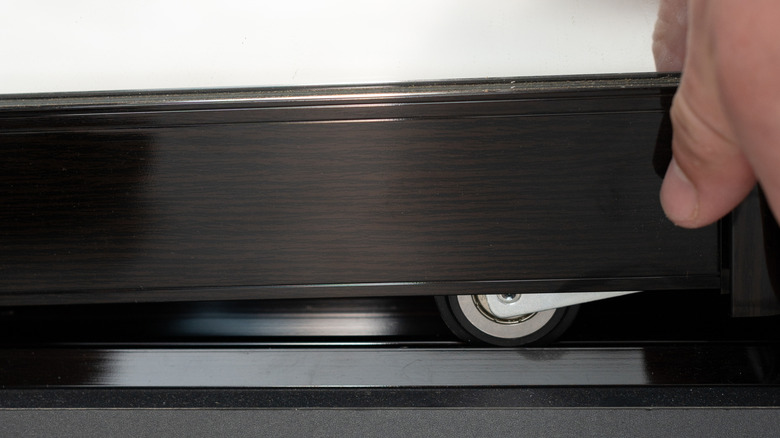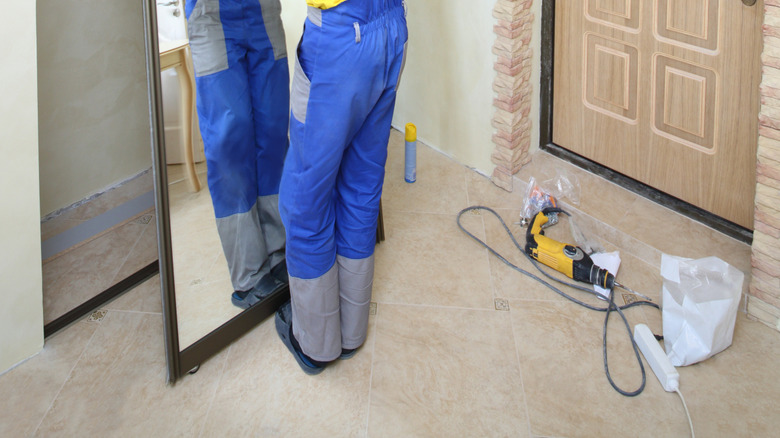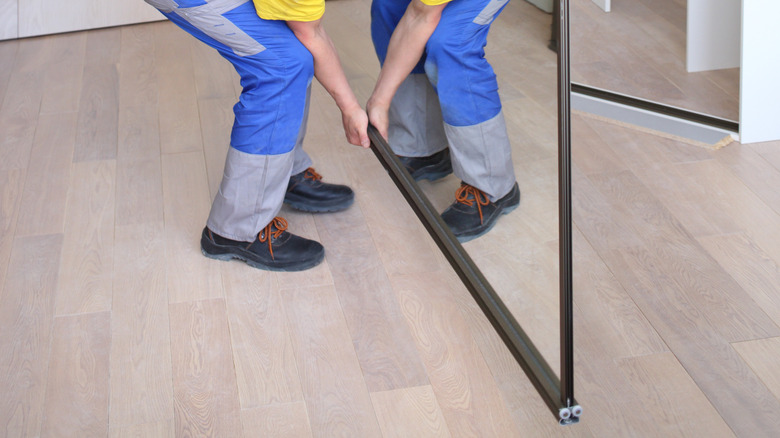The Common Reasons Your Mirror Closet Sliding Doors Are Getting Stuck (& How To Fix It)
We may receive a commission on purchases made from links.
Sliding mirrored closet doors can be as beautiful as they are functional. Their ability to make your space look bigger, fit in with any design aesthetic, and free up space in an otherwise small bedroom has made them a popular choice for closet doors for decades. They also provide that much-needed full-body reflection when you're getting ready, just to make sure you look your best when leaving the house. But for all their benefits, they have their downsides, especially when they become stuck on the track. You shouldn't need to put extra muscle into opening your closet doors when grime buildup takes over — and when you hear that screech of metal on metal, or one of them has jumped the track and it's wobbling back and forth, it can be frustrating.
Sliding closet doors can easily become difficult to use if they are neglected. That's why it's important to understand what's causing your sliding closet doors to get stuck and what you can do about it. The good news is that the problem is caused by just a few common issues, all of which are relatively easy to fix on your own. First, you need to identify what is causing the malfunction of your closet doors to find the right solution. So let's dig into why it could be happening, what to do about it, and how to prevent this frustrating problem from continuously happening.
When wheels jump the tracks
If your sliding closet doors seem to stick on one side or generally feel unbalanced, the wheels have probably dislodged from the track. This is one of the common issues that individuals with mirrored closet doors deal with. The wheels can pop out of place for various reasons, including track misalignment, severe impact, or simply due to age. You may notice this has happened not only when the door is difficult to slide, but also if you detect a visible gap between the door and the frame. This issue can even cause the door to scrape against the metal track, causing an audible grinding, scraping, or squeaking sound.
To fix this issue, you will need to remove the doors completely. It's not a bad idea to have a helper as these doors can be bulky and heavy to hold. You can typically remove the door by lifting gently upward to release the bottom wheels and then pulling the door away from the tracks. Make sure to lay the door on a soft surface or propped up against a secure wall to prevent damage to the mirrors. Then, inspect the wheels for damage and make sure the spring-loaded mechanism is functioning properly. You can usually find this inside the bottom frame of the door. If it is working properly, you should be able to press the wheel back into the track while pushing down on the spring to lock it into place.
When dirt and grime build up
One of the less obvious but very common reasons your closet doors are difficult to operate is the accumulation of dirt and grime. The tracks are a magnet for dust, pet hair, and other debris, which can often build up and cause the doors to stick. This is especially true when you add other elements, such as lubricating oil, because they will often all combine to make a paste and cause further resistance. This can result in sticking, squeaking, and sometimes even cause your doors to lock up completely. When this happens, you might be tempted to add more lubricating oil to the tracks to help with the problem. But that will likely make it worse, as the residue will only become further lodged in the wheels. The best way to fully solve the problem is to thoroughly clean the wheels and tracks.
For this issue, you will need to remove the doors completely. Once they are off, vacuum the tracks using a narrow nozzle attachment, if possible, to get deep into crevices and make sure you've removed all visible dirt and grime. You can follow up with a damp cloth to capture any remaining dust, but ensure all components are completely dry before reinstalling. If moisture is left on the tracks, it can cause rust and create further issues. Once you are done, apply a silicone-based lubricant, like WD-40 Specialist Silicone Lubricant, along the tracks before putting the doors back on — this will help them slide smoothly again. Making sure to clean the tracks regularly will help prevent future buildup issues.
Checking for loose screws
Just as important as checking for dislodged wheels and dirt build up, is inspecting the hardware of your tracks on a regular basis. If your closet doors have become difficult to operate, check for worn-out hardware. It is common for screws to become loose slowly over time, simply due to the vibration of everyday use. If you notice your door system wobbling or if there's a noticeable clunk sounds when you slide the doors open, you might need to tighten or replace the screws or other operating mechanisms. You should inspect the top and bottom of the tracks and use a screwdriver to test the screws. You should do this even if they don't look visibly loose, as a slight adjustment can make a big difference. Other hardware that holds the wheels in place should also be checked.
It's a good idea to remove the doors for the most thorough inspection. Once they are completely off, you can make your way through each component individually, replacing any stripped screws or worn brackets, and making sure the tracks themselves are securely tightened to the closet frame. When you reinstall the doors, you want to ensure they are installed properly. Any door that isn't fully level may put extra strain on hardware, causing unnecessary wear and could potentially cause bigger repair issues in the future. It's important to inspect your hardware regularly to prevent any long-term damage.
Knowing when to replace your wheels
If you've addressed all the above potential issues and your closet doors still aren't sliding smoothly, there's a chance the wheels themselves may be broken. Since the wheels hold up the full weight of the door, they are a vital part of the closet system and can become worn over time. Wheels can crack or flatten, especially in cheaper models, which can result in resistance as the door slides along the track. This issue often requires replacing the wheels, but it can fortunately be done relatively cheaply and without the need to hire a professional. For this fix, you will need to remove your doors entirely. Then locate the wheels, which can be only on the bottom or on the top and bottom, depending on your closet system.
Remove the old rollers and take one of them with you to your local hardware store to make sure you purchase the correct replacement. Ball-bearing wheels, similar to these TPard Sliding Mirror Closet Door Rollers, are often recommended due to their quiet operation, support for heavier doors, and longer lifespan. The installation of your new wheels is as easy as screwing them into your existing doors and making sure they are aligned straight. Once they are back on the tracks, test them to make sure they slide properly. Also, keep in mind that regularly cleaning and maintaining your closet door tracks will help them function better and last longer. So when you are creating your effective cleaning schedule, be sure to include them on your list.




